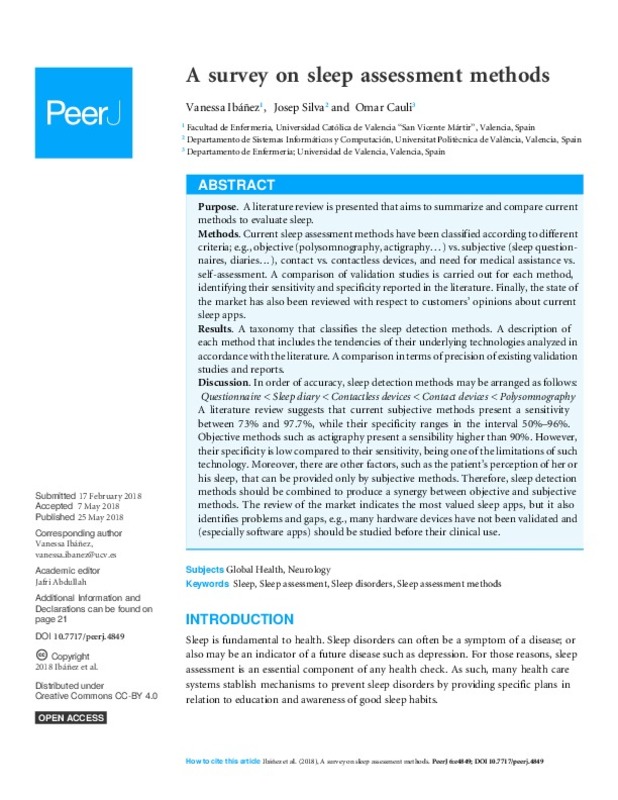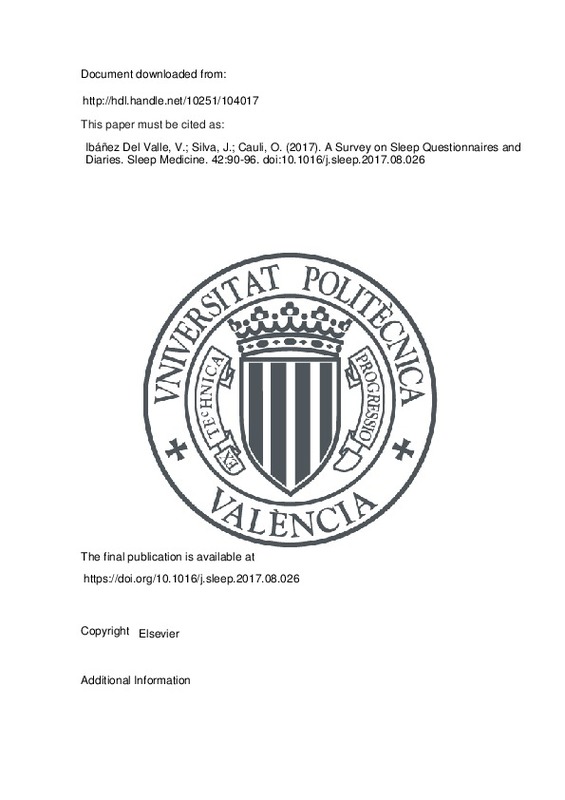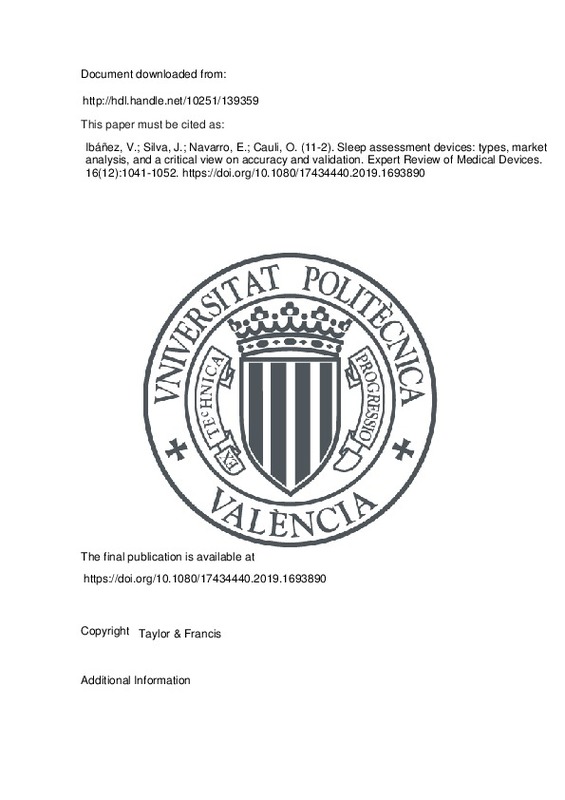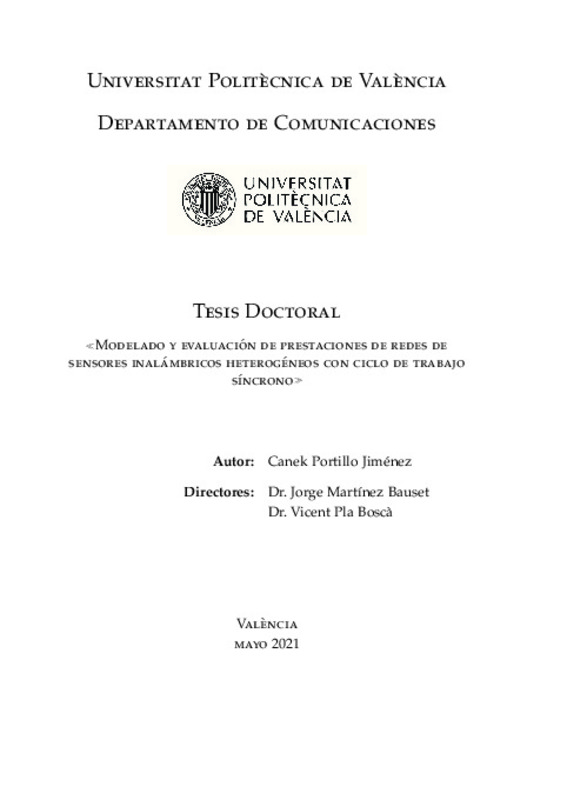JavaScript is disabled for your browser. Some features of this site may not work without it.
Buscar en RiuNet
Listar
Mi cuenta
Estadísticas
Ayuda RiuNet
Admin. UPV
A survey on sleep assessment methods
Mostrar el registro sencillo del ítem
Ficheros en el ítem
| dc.contributor.author | Ibáñez, Vanessa
|
es_ES |
| dc.contributor.author | Silva, Josep
|
es_ES |
| dc.contributor.author | Cauli, Omar
|
es_ES |
| dc.date.accessioned | 2020-02-28T21:00:32Z | |
| dc.date.available | 2020-02-28T21:00:32Z | |
| dc.date.issued | 2018 | es_ES |
| dc.identifier.uri | http://hdl.handle.net/10251/137997 | |
| dc.description.abstract | [EN] Purpose. A literature review is presented that aims to summarize and compare curren methods to evaluate sleep. Methods. Current sleep assessment methods have been classified according to different. criteria; e.g., objective (polysomnography actigraphy) vs.subjective (sleep questionnaires, diaries...), contact vs. contactless devices, and need for medical assistance vs. self-assessment. A comparison of validation studies is carried out for each method, identifying their sensitivity and specificity reported in the literature. Finally, the state of the market has also been reviewed with respect to customers' opinions about current sleep apps. Results. A taxonomy that classifies the sleep, detection methods. IA deseriPtion of each method that includes the tendencies of their underlying technologies lanalyzed in accordance with the literature. A comparison in terms, of precision of existing validation studies and reports. Discussion. In order of accuracy, sleep detection methods may be arranged as follows: Questionnaire < Sleep diary < Contactless devices < Contact devices < Polysotnnography A literature review suggests that current subjective methods present a sensitivity between 73% and 97.7%, while their specificity ranges in the interval 50%-96%. Objective methods such as actigraphy present a sensibility higher than 90%. However, their specificity is low compared to their sensitivity, being one of the limitations of such technology. Moreover, there are other factors, such as the Patients Perception of her or his sleep, that can be provided only by subjective methods. Therefore, sleep detection methods should be combined to produce a synergy between objective and subjective methods. The review of the market indicates the most valued sleep apps, but it also identifies problems and gaps, e.g., many hardware devices have not been validated and (especially software apps) should be studied before their clinical use. | es_ES |
| dc.language | Inglés | es_ES |
| dc.publisher | PeerJ | es_ES |
| dc.relation.ispartof | PeerJ | es_ES |
| dc.rights | Reconocimiento (by) | es_ES |
| dc.subject | Sleep | es_ES |
| dc.subject | Sleep assessment | es_ES |
| dc.subject | Sleep disorders | es_ES |
| dc.subject | Sleep assessment methods | es_ES |
| dc.subject.classification | LENGUAJES Y SISTEMAS INFORMATICOS | es_ES |
| dc.title | A survey on sleep assessment methods | es_ES |
| dc.type | Artículo | es_ES |
| dc.identifier.doi | 10.7717/peerj.4849 | es_ES |
| dc.rights.accessRights | Abierto | es_ES |
| dc.contributor.affiliation | Universitat Politècnica de València. Departamento de Sistemas Informáticos y Computación - Departament de Sistemes Informàtics i Computació | es_ES |
| dc.description.bibliographicCitation | Ibáñez, V.; Silva, J.; Cauli, O. (2018). A survey on sleep assessment methods. PeerJ. 6:1-26. https://doi.org/10.7717/peerj.4849 | es_ES |
| dc.description.accrualMethod | S | es_ES |
| dc.relation.publisherversion | https://doi.org/10.7717/peerj.4849 | es_ES |
| dc.description.upvformatpinicio | 1 | es_ES |
| dc.description.upvformatpfin | 26 | es_ES |
| dc.type.version | info:eu-repo/semantics/publishedVersion | es_ES |
| dc.description.volume | 6 | es_ES |
| dc.identifier.eissn | 2167-8359 | es_ES |
| dc.relation.pasarela | S\379109 | es_ES |
| dc.description.references | Baandrup, L., & Jennum, P. (2015). A validation of wrist actigraphy against polysomnography in patients with schizophrenia or bipolar disorder. Neuropsychiatric Disease and Treatment, 2271. doi:10.2147/ndt.s88236 | es_ES |
| dc.description.references | Bhat, S., Ferraris, A., Gupta, D., Mozafarian, M., DeBari, V. A., Gushway-Henry, N., … Chokroverty, S. (2015). Is There a Clinical Role For Smartphone Sleep Apps? Comparison of Sleep Cycle Detection by a Smartphone Application to Polysomnography. Journal of Clinical Sleep Medicine, 11(07), 709-715. doi:10.5664/jcsm.4840 | es_ES |
| dc.description.references | Bobes, J., González, M. P., Vallejo, J., Sáiz, J., Gibert, J., Ayuso, J. L., & Rico, F. (1998). Oviedo Sleep Questionnaire (OSQ): A new semistructured Interview for sleep disorders. European Neuropsychopharmacology, 8, S162. doi:10.1016/s0924-977x(98)80198-3 | es_ES |
| dc.description.references | Boyne, K., Sherry, D. D., Gallagher, P. R., Olsen, M., & Brooks, L. J. (2012). Accuracy of computer algorithms and the human eye in scoring actigraphy. Sleep and Breathing, 17(1), 411-417. doi:10.1007/s11325-012-0709-z | es_ES |
| dc.description.references | Buysse, D. J., Reynolds, C. F., Monk, T. H., Berman, S. R., & Kupfer, D. J. (1989). The Pittsburgh sleep quality index: A new instrument for psychiatric practice and research. Psychiatry Research, 28(2), 193-213. doi:10.1016/0165-1781(89)90047-4 | es_ES |
| dc.description.references | Carney, C. E., Buysse, D. J., Ancoli-Israel, S., Edinger, J. D., Krystal, A. D., Lichstein, K. L., & Morin, C. M. (2012). The Consensus Sleep Diary: Standardizing Prospective Sleep Self-Monitoring. Sleep, 35(2), 287-302. doi:10.5665/sleep.1642 | es_ES |
| dc.description.references | Carskadon, M. A. (1986). Guidelines for the Multiple Sleep Latency Test (MSLT): A Standard Measure of Sleepiness. Sleep, 9(4), 519-524. doi:10.1093/sleep/9.4.519 | es_ES |
| dc.description.references | Chai-Coetzer, C. L., Antic, N. A., Rowland, L. S., Catcheside, P. G., Esterman, A., Reed, R. L., … McEvoy, R. D. (2011). A simplified model of screening questionnaire and home monitoring for obstructive sleep apnoea in primary care. Thorax, 66(3), 213-219. doi:10.1136/thx.2010.152801 | es_ES |
| dc.description.references | Chasens, E. R., Ratcliffe, S. J., & Weaver, T. E. (2009). Development of the FOSQ-10: A Short Version of the Functional Outcomes of Sleep Questionnaire. Sleep, 32(7), 915-919. doi:10.1093/sleep/32.7.915 | es_ES |
| dc.description.references | Chung, F., Yegneswaran, B., Liao, P., Chung, S. A., Vairavanathan, S., Islam, S., … Shapiro, C. M. (2008). STOP Questionnaire. Anesthesiology, 108(5), 812-821. doi:10.1097/aln.0b013e31816d83e4 | es_ES |
| dc.description.references | Cruz, S., Littner, M., & Zeidler, M. (2014). Home Sleep Testing for the Diagnosis of Obstructive Sleep Apnea—Indications and Limitations. Seminars in Respiratory and Critical Care Medicine, 35(05), 552-559. doi:10.1055/s-0034-1390066 | es_ES |
| dc.description.references | De Zambotti, M., Baker, F. C., & Colrain, I. M. (2015). Validation of Sleep-Tracking Technology Compared with Polysomnography in Adolescents. Sleep, 38(9), 1461-1468. doi:10.5665/sleep.4990 | es_ES |
| dc.description.references | De Zambotti, M., Claudatos, S., Inkelis, S., Colrain, I. M., & Baker, F. C. (2015). Evaluation of a consumer fitness-tracking device to assess sleep in adults. Chronobiology International, 32(7), 1024-1028. doi:10.3109/07420528.2015.1054395 | es_ES |
| dc.description.references | Douglass, A. B., Bomstein, R., Nino-Murcia, G., Keenan, S., Miles, L., Zarcone, V. P., … Dement, W. C. (1994). The Sleep Disorders Questionnaire I: Creation and Multivariate Structure of SDQ. Sleep, 17(2), 160-167. doi:10.1093/sleep/17.2.160 | es_ES |
| dc.description.references | El-Sayed, I. H. (2012). Comparison of four sleep questionnaires for screening obstructive sleep apnea. Egyptian Journal of Chest Diseases and Tuberculosis, 61(4), 433-441. doi:10.1016/j.ejcdt.2012.07.003 | es_ES |
| dc.description.references | Evenson, K. R., Goto, M. M., & Furberg, R. D. (2015). Systematic review of the validity and reliability of consumer-wearable activity trackers. International Journal of Behavioral Nutrition and Physical Activity, 12(1). doi:10.1186/s12966-015-0314-1 | es_ES |
| dc.description.references | FIRAT, H., YUCEEGE, M., DEMIR, A., & ARDIC, S. (2012). Comparison of four established questionnaires to identify highway bus drivers at risk for obstructive sleep apnea in Turkey. Sleep and Biological Rhythms, 10(3), 231-236. doi:10.1111/j.1479-8425.2012.00566.x | es_ES |
| dc.description.references | WARD FLEMONS, W., & REIMER, M. A. (1998). Development of a Disease-specific Health-related Quality of Life Questionnaire for Sleep Apnea. American Journal of Respiratory and Critical Care Medicine, 158(2), 494-503. doi:10.1164/ajrccm.158.2.9712036 | es_ES |
| dc.description.references | Flemons, W. W., Whitelaw, W. A., Brant, R., & Remmers, J. E. (1994). Likelihood ratios for a sleep apnea clinical prediction rule. American Journal of Respiratory and Critical Care Medicine, 150(5), 1279-1285. doi:10.1164/ajrccm.150.5.7952553 | es_ES |
| dc.description.references | Ibáñez, V., Silva, J., & Cauli, O. (2018). A survey on sleep questionnaires and diaries. Sleep Medicine, 42, 90-96. doi:10.1016/j.sleep.2017.08.026 | es_ES |
| dc.description.references | Jungquist, C. R., Pender, J. J., Klingman, K. J., & Mund, J. (2015). Validation of Capturing Sleep Diary Data via a Wrist-Worn Device. Sleep Disorders, 2015, 1-6. doi:10.1155/2015/758937 | es_ES |
| dc.description.references | Kelly, J. M., Strecker, R. E., & Bianchi, M. T. (2012). Recent Developments in Home Sleep-Monitoring Devices. ISRN Neurology, 2012, 1-10. doi:10.5402/2012/768794 | es_ES |
| dc.description.references | Lee, J., Hong, M., & Ryu, S. (2015). Sleep Monitoring System Using Kinect Sensor. International Journal of Distributed Sensor Networks, 2015, 1-9. doi:10.1155/2015/875371 | es_ES |
| dc.description.references | Lorenz, C. P., & Williams, A. J. (2017). Sleep apps. Current Opinion in Pulmonary Medicine, 23(6), 512-516. doi:10.1097/mcp.0000000000000425 | es_ES |
| dc.description.references | Marino, M., Li, Y., Rueschman, M. N., Winkelman, J. W., Ellenbogen, J. M., Solet, J. M., … Buxton, O. M. (2013). Measuring Sleep: Accuracy, Sensitivity, and Specificity of Wrist Actigraphy Compared to Polysomnography. Sleep, 36(11), 1747-1755. doi:10.5665/sleep.3142 | es_ES |
| dc.description.references | Martin, J. L., & Hakim, A. D. (2011). Wrist Actigraphy. Chest, 139(6), 1514-1527. doi:10.1378/chest.10-1872 | es_ES |
| dc.description.references | Meira, L., van Zeller, M., Eusébio, E., Clara, E. S., Viana, P., & Drummond, M. (2017). Maintenance of Wakefulness Test in clinical practice. Chronobiology and other sleep disorders. doi:10.1183/23120541.sleepandbreathing-2017.p5 | es_ES |
| dc.description.references | Meltzer, L. J., Hiruma, L. S., Avis, K., Montgomery-Downs, H., & Valentin, J. (2015). Comparison of a Commercial Accelerometer with Polysomnography and Actigraphy in Children and Adolescents. Sleep, 38(8), 1323-1330. doi:10.5665/sleep.4918 | es_ES |
| dc.description.references | Meltzer, L. J., Wong, P., Biggs, S. N., Traylor, J., Kim, J. Y., Bhattacharjee, R., … Marcus, C. L. (2016). Validation of Actigraphy in Middle Childhood. Sleep, 39(6), 1219-1224. doi:10.5665/sleep.5836 | es_ES |
| dc.description.references | Min, J.-K., Doryab, A., Wiese, J., Amini, S., Zimmerman, J., & Hong, J. I. (2014). Toss «n» turn. Proceedings of the 32nd annual ACM conference on Human factors in computing systems - CHI ’14. doi:10.1145/2556288.2557220 | es_ES |
| dc.description.references | MONK, T. H., REYNOLDS, C. F., KUPFER, D. J., BUYSSE, D. J., COBLE, P. A., HAYES, A. J., … RITENOUR, A. M. (1994). The Pittsburgh Sleep Diary. Journal of Sleep Research, 3(2), 111-120. doi:10.1111/j.1365-2869.1994.tb00114.x | es_ES |
| dc.description.references | Using a Questionnaire to Help Identify Patients with Sleep Apnea. (1999). Annals of Internal Medicine, 131(7), 485. doi:10.7326/0003-4819-131-7-199910050-00041 | es_ES |
| dc.description.references | Pandi-Perumal, S. R., Spence, D. W., & BaHammam, A. S. (2014). Polysomnography: An Overview. Primary Care Sleep Medicine, 29-42. doi:10.1007/978-1-4939-1185-1_4 | es_ES |
| dc.description.references | Sateia, M. J. (2014). International Classification of Sleep Disorders-Third Edition. Chest, 146(5), 1387-1394. doi:10.1378/chest.14-0970 | es_ES |
| dc.description.references | Silva, G., Goodwin, J., Vana, K., & Quan, S. (2016). Obstructive sleep apnea and quality of life: comparison of the SAQLI, FOSQ, and SF-36 questionnaires. Southwest Journal of Pulmonary and Critical Care, 13(3), 137-149. doi:10.13175/swjpcc082-16 | es_ES |
| dc.description.references | Silva, G. E., Vana, K. D., Goodwin, J. L., Sherrill, D. L., & Quan, S. F. (2011). Identification of Patients with Sleep Disordered Breathing: Comparing the Four-Variable Screening Tool, STOP, STOP-Bang, and Epworth Sleepiness Scales. Journal of Clinical Sleep Medicine, 07(05), 467-472. doi:10.5664/jcsm.1308 | es_ES |
| dc.description.references | Sitnick, S. L., Goodlin-Jones, B. L., & Anders, T. F. (2008). The Use of Actigraphy to Study Sleep Disorders in Preschoolers: Some Concerns about Detection of Nighttime Awakenings. Sleep, 31(3), 395-401. doi:10.1093/sleep/31.3.395 | es_ES |
| dc.description.references | Sivertsen, B., Omvik, S., Havik, O. E., Pallesen, S., Bjorvatn, B., Nielsen, G. H., … Nordhus, I. H. (2006). A Comparison of Actigraphy and Polysomnography in Older Adults Treated for Chronic Primary Insomnia. Sleep, 29(10), 1353-1358. doi:10.1093/sleep/29.10.1353 | es_ES |
| dc.description.references | Sullivan, S. S., & Kushida, C. A. (2008). Multiple Sleep Latency Test and Maintenance of Wakefulness Test. Chest, 134(4), 854-861. doi:10.1378/chest.08-0822 | es_ES |











